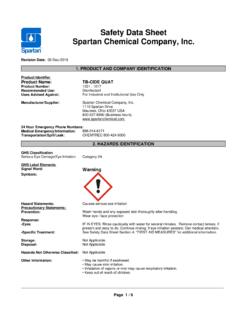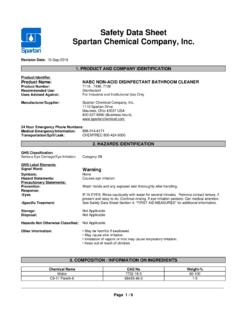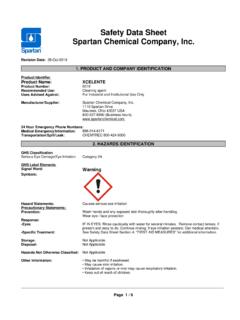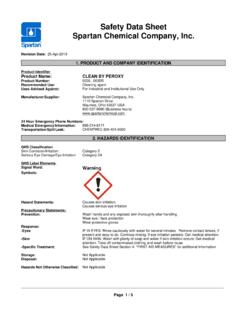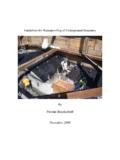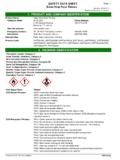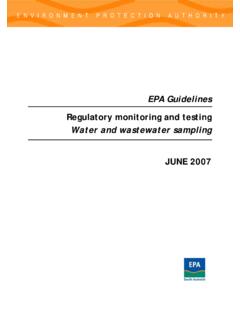Transcription of Safety Data Sheet Spartan Chemical Company, Inc.
1 Revision Date: 02-Jul-2021 1. PRODUCT AND COMPANY IDENTIFICATION Product Identifier Product Name: HDQ NEUTRAL Product Number: 1202 Recommended Use: Disinfectant Uses Advised Against: For Industrial and Institutional Use Only Manufacturer/Supplier: Spartan Chemical Company, Spartan DriveMaumee, Ohio 43537 USA 800-537-8990 (Business hours) 24 Hour Emergency Phone Numbers: Medical Emergency/Information: 888-314-6171 Transportation/Spill/Leak: CHEMTREC 800-424-9300 2. HAZARDS IDENTIFICATION GHS Classification Acute Toxicity - Oral: Category 4 Acute toxicity - Inhalation (Dusts/Mists) Category 4 Skin Corrosion/Irritation: Category 1 Sub-category B Serious Eye Damage/Eye Irritation: Category 1 GHS Label Elements Signal Word: Danger Hazard Statements: Harmful if if severe skin burns and serious eye damage.
2 Precautionary Statements: Prevention: Wash hands and any exposed skin thoroughly after not eat, drink or smoke when using this productDo not breathe mist, vapors or only outdoors or in a well-ventilated areaWear protective gloves. Wear eye / face protection. Wear protective clothing. Response: IMMEDIATELY CALL A POISON CENTER OR PHYSICIAN. -Eyes IF IN EYES: Rinse cautiously with water for several minutes. Remove contact lenses, if present and easy to do. Continue rinsing. -Skin IF ON SKIN (or hair): Take off immediately all contaminated clothing. Rinse skin with water or shower. Wash contaminated clothing before reuse. -Inhalation: IF INHALED: Remove victim to fresh air and keep at rest in a position comfortable for Safety Data SheetSpartan Chemical Company, Inc.
3 Symbols: _____ Page 1 / 6 _____ 1202 - HDQ NEUTRAL Revision Date: 02-Jul-2021 breathing. -Ingestion: IF SWALLOWED: Rinse mouth. Do NOT induce vomiting. -Specific Treatment: See Safety Data Sheet Section 4: "FIRST AID MEASURES" for additional information. Storage: Store locked up. Disposal: Dispose of contents and container in accordance with local, state and federal regulations. Hazards Not Otherwise Classified: Not Applicable Other Information: Corrosive Keep out of reach of children NOTE TO PHYSICIAN: Probable mucosal damage may contraindicate the use of gastric lavage. 3. COMPOSITION / INFORMATION ON INGREDIENTS Chemical Name CAS No Weight-% Water 7732-18-5 60-100 Didecyldimethylammonium Chloride 7173-51-5 3-7 Alkyl C12-16 Dimethylbenzyl Ammonium Chloride 68424-85-1 1-5 Alcohol 64-17-5 1-5 Tetrasodium EDTA 64-02-8 1-5 C9-11 Pareth-6 68439-46-3 1-5 Citric Acid 77-92-9 Orange Terpenes 68647-72-3 < Terpene Hydrocarbons 68956-56-9 < Lemon Oil Terpenes 68917-33-9 < Citronellyl Nitrile 51566-62-2 < Fragrance PROPRIETARY < CI 15620 1658-56-6 < Specific Chemical identity and/or exact percentage of composition has been withheld as a trade secret.
4 4. FIRST AID MEASURES -Eye Contact: Rinse cautiously with water for at least 15 minutes. Remove contact lenses, if present and easy to do. Continue rinsing. IMMEDIATELY CALL A POISON CENTER OR PHYSICIAN. -Skin Contact: Take off immediately all contaminated clothing and shoes. Rinse with water or shower for at least 15 minutes. IMMEDIATELY CALL A POISON CENTER OR PHYSICIAN. Wash contaminated clothing before reuse. -Inhalation: Remove victim to fresh air and keep at rest in a position comfortable for breathing. IMMEDIATELY CALL A POISON CENTER OR PHYSICIAN. -Ingestion: Rinse mouth. Do NOT induce vomiting. IMMEDIATELY CALL A POISON CENTER OR PHYSICIAN. Never give anything by mouth to an unconscious person.
5 Note to Physicians: NOTE TO PHYSICIAN: Probable mucosal damage may contraindicate the use of gastric lavage. Treat symptomatically. 5. FIRE-FIGHTING MEASURES Suitable Extinguishing Media: Product does not support combustion, Use extinguishing agent suitable for type of surrounding fire Specific Hazards Arising from the Chemical : Dried product is capable of burning. Combustion products are toxic. Hazardous Combustion Products: May include Carbon monoxide Carbon dioxide and other toxic gases or vapors. Protective Equipment and Wear MSHA/NIOSH approved self-contained breathing apparatus (SCBA) and full _____ Page 2 / 6 _____ 1202 - HDQ NEUTRAL Revision Date: 02-Jul-2021 Precautions for Firefighters: protective gear.
6 Cool fire-exposed containers with water spray. 6. ACCIDENTAL RELEASE MEASURES Personal Precautions: Avoid contact with skin, eyes or clothing. Use personal protective equipment as required. Environmental Precautions: Do not rinse spill onto the ground, into storm sewers or bodies of water. Methods for Clean-Up: Prevent further leakage or spillage if safe to do so. Contain and collect spillage with non-combustible absorbent material, ( sand, earth, diatomaceous earth, vermiculite) and place in container for disposal according to local / national regulations (see Section 13). 7. HANDLING AND STORAGE Advice on Safe Handling: Handle in accordance with good industrial hygiene and Safety practice. Wash thoroughly after handling.
7 Storage Conditions: Keep containers tightly closed in a dry, cool and well-ventilated place. Keep out of the reach of children. Keep from freezing. Suggested Shelf Life: 1 year from date of manufacture. 8. EXPOSURE CONTROLS / PERSONAL PROTECTION Occupational Exposure Limits: Chemical Name ACGIH TLV OSHA PEL NIOSH Alcohol 64-17-5 STEL: 1000 ppm TWA: 1000 ppm TWA: 1900 mg/m3 (vacated) TWA: 1000 ppm (vacated) TWA: 1900 mg/m3 IDLH: 3300 ppm TWA: 1000 ppm TWA: 1900 mg/m3 Engineering Controls: Provide good general work practices generate dust, fumes, gas, vapors or mists which expose workers to chemicals above the occupational exposure limits, local exhaust ventilation or other engineering controls should be wash stations and shower facilities should be readily accessible in areas where the product is handled.
8 Personal Protective Equipment Eye/Face Protection: Wear splash goggles. Skin and Body Protection: Wear rubber or other Chemical -resistant gloves. Respiratory Protection: Not required with expected occupational exposure limits are exceeded or respiratory irritation occurs, use of a NIOSH/MSHA approved respirator suitable for the use-conditions and chemicals in Section 3 should be considered. General Hygiene Considerations: Wash hands and any exposed skin thoroughly after 29 CFR for further guidance. _____ Page 3 / 6 _____ 1202 - HDQ NEUTRAL Revision Date: 02-Jul-2021 10. STABILITY AND REACTIVITY Reactivity: This material is considered to be non-reactive under normal conditions of use. Chemical Stability: Stable under normal conditions.
9 Possibility of Hazardous Reactions: Not expected to occur with normal handling and storage. Conditions to Avoid: Extremes of temperature and direct sunlight. Incompatible Materials: Strong oxidizing agents. Strong acids. Hazardous Decomposition Products: May include carbon monoxide, carbon dioxide (CO2) and other toxic gases or vapors. 11. TOXICOLOGICAL INFORMATION Likely Routes of Exposure: Eyes, Skin, Ingestion, Inhalation. Symptoms of Exposure: -Eye Contact: Pain, redness, swelling of the conjunctiva and tissue damage. Eye contact may cause permanent damage. -Skin Contact: Pain, redness, blistering and possible Chemical burn. -Inhalation: Nasal discomfort and coughing. Irritation or damage to the mucus membranes of the respiratory tract.
10 -Ingestion: Damage or Chemical burns to mouth, throat and stomach. Pain, nausea, vomiting and diarrhea. Immediate, Delayed, Chronic Effects Product Information: Data not available or insufficient for classification. Numerical Measures of Toxicity The following acute toxicity estimates (ATE) are calculated based on the GHS document. ATEmix (oral): 1435 mg/kg ATEmix (dermal): 49782 mg/kg ATEmix (inhalation-dust/mist): mg/l Component Acute Toxicity Information Chemical Name Oral LD50 Dermal LD50 Inhalation LC50 Water 7732-18-5 > 90 mL/kg ( Rat ) Not Available Not Available Didecyldimethylammonium Chloride = 84 mg/kg ( Rat ) Not Available Not Available 9. PHYSICAL AND Chemical PROPERTIES Appearance/Physical State: Liquid Color: Red Odor: Mild Citrus fragrance pH: Melting Point / Freezing Point: No information available Boiling Point / Boiling Range: 100 C / 212 F Flash Point: > 100 C / > 212 F Evaporation Rate: < 1 (Butyl acetate = 1) Flammability (solid, gas) No information available Upper Flammability Limit: No information available Lower Flammability Limit: No information available Vapor Pressure: No information available Vapor Density: No information available Specific Gravity: Solubility(ies): Soluble in water Partition Coefficient: No information available Autoignition Temperature.



